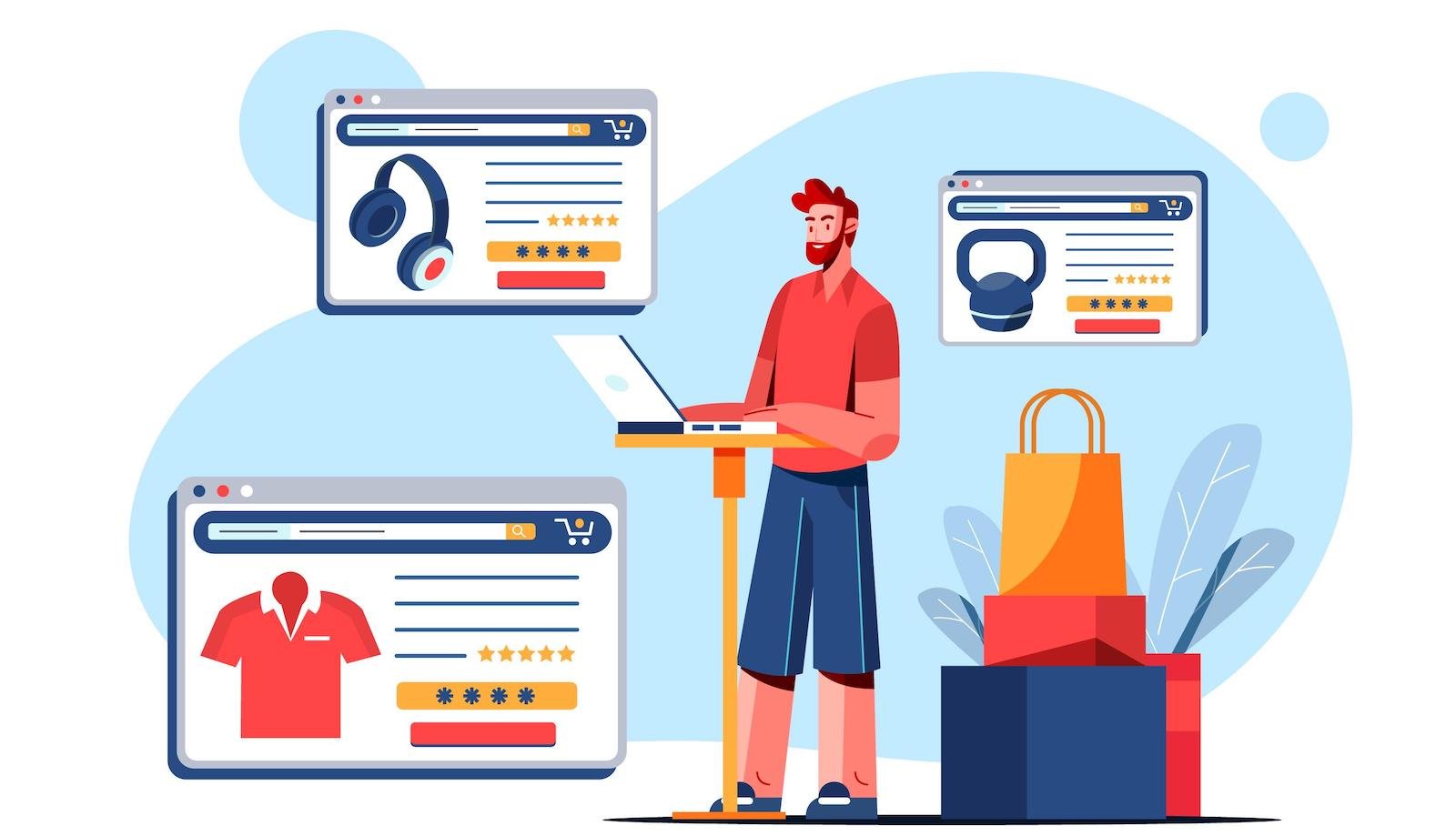- Magoven
- 0 Comments
- 224 Views
Ecommerce websites are becoming increasingly popular as more businesses move their operations online. With the rise of ecommerce, it’s important to understand the essential features that make up a successful ecommerce website. In this blog post, we will explore some of the must-have features for ecommerce websites including shopify, product page, seo, and homepage and how they can improve the user experience.
One of the main features of an ecommerce website, especially for online stores using Shopify, is an easy-to-use checkout process. A complicated checkout process can lead to cart abandonment, which negatively impacts the conversion rate. To avoid this, it’s important to have a clear and concise checkout page that allows customers to check their order details before finalizing the purchase. The checkout process should also allow customers to easily input their shipping and billing information without having to create an account, especially for new customers. Implementing features such as a progress bar or a one-page checkout process can make the checkout process feel more manageable and less overwhelming for customers. It’s also important to have a user-friendly homepage and product catalog to encourage customers to explore and make purchases on the website.
Another essential feature for ecommerce websites is mobile responsiveness. With more people using their smartphones and tablets to shop online, it’s crucial that your website is optimized for mobile devices. This means ensuring that your website design is responsive and adapts to different screen sizes. In addition, incorporating Shopify into your website can provide a seamless shopping experience for customers. Utilizing SEO features can increase visibility and traffic to your product page, while customer reviews can help build trust and credibility with potential buyers.
In addition to mobile responsiveness, having high-quality product images and descriptions is also important for ecommerce websites such as Shopify online stores. Customers want to know exactly what they’re buying before making a purchase, so providing them with detailed product information can help increase conversions and improve SEO features. Additionally, incorporating design features into the website can enhance the overall user experience and attract more potential customers.
To add these features (and others) to your Shopify ecommerce website, you may need to work with an experienced web designer or developer who specializes in Shopify platform development. They can help you identify which capabilities are most important for your business and implement them in a way that improves user experience (UX) on your product page while also optimizing your site for search engines (SEO). Additionally, integrating customer reviews into your product page can enhance the shopping experience for potential buyers.
Improving UX is critical in ecommerce website design as you can create a more enjoyable shopping experience on your ecommerce store that keeps customers coming back. Shopify and other ecommerce platforms rely heavily on good UX to ensure customers are satisfied with their online shopping experience.
At OuterBox, we have extensive experience adding ecommerce features to websites. Our team of web designers and developers specialize in ecommerce website design and development, so we understand the importance of creating a user-friendly and optimized online store. Whether you need help with mobile responsiveness, checkout optimization, or anything else related to ecommerce site design, our team is here to help. We also have capabilities in SEO and can optimize your platform’s menu for better user experience.
Must-Have Features for Ecommerce Websites: A Comprehensive List
 Customizable Ecommerce Platforms
Customizable Ecommerce Platforms
Ecommerce platforms offer a wide range of capabilities that can be customized to meet the specific needs of an online store. Customization is essential because no two ecommerce businesses are the same, and each has its unique set of requirements. A good ecommerce platform should allow businesses to select from various templates, themes, and plugins to create a website that reflects their brand identity. Moreover, it should provide flexibility in design and menu to ensure the website looks professional and user-friendly. Additionally, it should have built-in SEO features to help businesses optimize their website for search engines.
Payment Processing
Payment processing is one of the most critical features for any ecommerce store. Customers and visitors want a seamless payment experience that is both secure and convenient, and it is important for SEO to have a platform that supports multiple payment options such as credit cards, debit cards, PayPal, Apple Pay, Google Wallets, etc. The payment gateway should be integrated with SSL encryption technology to ensure safe transactions.
Inventory Management
Effective inventory management is a crucial and important feature for any ecommerce store as it helps maintain optimal stock levels and avoid overselling or underselling products. An excellent ecommerce platform should provide real-time inventory tracking tools that enable businesses to monitor product availability across multiple channels accurately. Additionally, it should have automated alerts when stock levels fall below a certain threshold so that businesses can reorder products on time. A well-designed website navigation and website design features are also essential for an ecommerce store to ensure a smooth customer experience.
Product Reviews and Ratings
Customers heavily rely on product reviews and ratings before making purchase decisions, making customer reviews and ratings functionality an essential feature for any ecommerce platform. This feature allows customers to leave feedback about products they have purchased in the past or rate them on a scale of 1-5 stars based on their experiences with them, boosting customer confidence in purchasing products from your store. Additionally, incorporating SEO features and design features into your platform can enhance the visibility and appeal of your ecommerce website, ultimately driving more traffic and sales.
Shipping Options
 Providing flexible shipping options is a crucial store feature that can help attract more customers by catering to their delivery preferences. An excellent ecommerce platform must integrate with major shipping carriers like USPS, FedEx, UPS, etc., so that businesses can provide accurate shipping rates and delivery times. Additionally, it should allow businesses to offer free shipping for orders above a certain amount or promotional offers. To enhance the store’s website design features, it should have an easy-to-use website navigation system that makes it simple for customers to browse through products and make purchases. Furthermore, integrating SEO features into the website design can help improve search engine rankings and attract more organic traffic to the store.
Providing flexible shipping options is a crucial store feature that can help attract more customers by catering to their delivery preferences. An excellent ecommerce platform must integrate with major shipping carriers like USPS, FedEx, UPS, etc., so that businesses can provide accurate shipping rates and delivery times. Additionally, it should allow businesses to offer free shipping for orders above a certain amount or promotional offers. To enhance the store’s website design features, it should have an easy-to-use website navigation system that makes it simple for customers to browse through products and make purchases. Furthermore, integrating SEO features into the website design can help improve search engine rankings and attract more organic traffic to the store.
Mobile Responsiveness
With more people shopping on their mobile devices than ever before, having a mobile-responsive ecommerce website is critical. A good ecommerce platform should provide responsive design templates that automatically adjust the layout and content of the website based on the screen size of the device being used. This ensures that customers have an optimal browsing and shopping experience regardless of the device they are using. Additionally, the platform should offer SEO features to help improve the store’s visibility on search engines.
Feature #1: User-Friendly Menu and Navigation
Friendly Navigation: Enhancing User Experience
A user-friendly navigation bar is one of the most crucial features for any ecommerce store platform. It enhances the user experience by making it easier for users to find what they are looking for on the website, while also improving the site’s SEO. Here are some key points to consider when designing a user-friendly navigation system.
Website Design Features
One of the essential design features of ecommerce websites is clear and concise labeling, which helps users understand what each section or page of an ecommerce store contains. Dropdown menus can also be used on ecommerce platforms to provide more detailed information about specific categories or products. Additionally, breadcrumb trails help users keep track of their location within the site and navigate back to previous pages quickly, which can also improve the SEO of the ecommerce store.
Mobile Devices
With mobile devices increasingly being used to access ecommerce sites, it’s vital that websites have responsive design features that optimize navigation on smaller screens. Mobile-responsive designs ensure that users can easily navigate through all sections of an ecommerce site without having to zoom in or scroll excessively. This is particularly important for SEO purposes as search engines prefer mobile-friendly sites. Additionally, having a responsive platform ensures that your online store is accessible to a wider audience, increasing the chances of conversions.
Homepage Menu
The menu on the homepage of ecommerce stores should be well-organized and provide easy access to all important features of the site, including customer service and content. It should also be designed using appropriate colors and fonts that complement the overall theme of the ecommerce platform. To improve visibility on search engines, it’s important to ensure that the menu is optimized for SEO.
Feature #2: Well-Designed Shopping Cart
Easy to Find and Access
The shopping cart is an essential part of any ecommerce store platform. It’s where customers add items they wish to purchase, view the total cost of their order, and proceed to checkout. A well-designed shopping cart with SEO features should be easy to find and access on the website. Customers should not have to search for it or navigate through multiple pages to get there.
Clear Instructions
Once customers have located the shopping cart on your ecommerce store, clear instructions on how to use ecommerce features are essential for a seamless shopping experience. They should be able to easily add or remove items from their cart with a few clicks of a button, thanks to your well-designed ecommerce website design. The process should be straightforward and intuitive, regardless of which of the many ecommerce platforms you use, without any confusion or frustration.
Well-Organized Product Catalog
A well-organized product catalog is crucial for any ecommerce store, as it provides a positive shopping experience for customers. The catalog should be visually appealing, with high-quality images that showcase each product’s details. Products should also be categorized logically so that customers can quickly find what they’re looking for. Additionally, incorporating SEO features into the platform can help improve visibility and attract more potential customers.
Customizable Designs
Online stores using platforms like Shopify can take advantage of customizable shopping cart designs to match their store’s branding. In addition, these platforms offer SEO features that can help businesses improve their online visibility and drive more traffic to their website. This allows businesses to create a seamless experience for their customers by maintaining consistent design elements throughout the entire purchasing process.
Delivery and Shipping Options
Delivery and shipping options play a significant role in the overall customer experience of an ecommerce store. These options should be clearly displayed within the shopping cart, including estimated delivery times and costs, to improve the platform’s SEO. Customers appreciate transparency as this helps them plan accordingly and boosts the platform’s visibility.
Additional Features
Finally, an optimized platform with additional features such as gift registries and user-generated content can enhance the overall convenience of the shopping experience and improve SEO. Gift registries allow users to create lists of products they would like others to purchase for them, while user-generated content provides social proof that can help increase sales.
Feature #3: Easy-to-Use Checkout Process
Secure payment options are a must-have for any ecommerce website to improve SEO. However, it is not enough to just offer secure payment options; the checkout process should also be easy-to-use and streamlined to provide a positive customer experience, which can boost your website’s SEO.
Secure Payment Options
Customers want to feel safe when making online purchases. Providing secure payment options is critical to building trust with customers and improving SEO. It is important to ensure that all payment options comply with industry standards and that they are encrypted so that sensitive information cannot be intercepted by hackers, which can positively impact your website’s SEO.
Multiple Payment Options
Offering multiple payment options can increase customer satisfaction and sales. Customers have different preferences so providing a variety of options can make the checkout process more convenient for them. Some popular payment options include credit/debit cards, PayPal, and Apple Pay. By offering a range of payment options, businesses can improve their SEO by catering to a wider audience and increasing their online visibility.
Clear Information
Providing clear information about payment options and security measures can help build trust with customers and improve your website’s SEO. This includes displaying logos of accepted payment methods on the checkout page, explaining how payments are processed, and highlighting any security features such as SSL encryption that can positively impact your SEO efforts.
Easy Checkout Process
An easy-to-use checkout process can significantly improve the customer experience and increase conversion rates for your ecommerce site’s SEO. A complicated or confusing checkout process can lead to cart abandonment, which means lost sales and poor SEO rankings. The checkout page should be simple and straightforward, allowing customers to easily review their order details, enter their shipping information for better SEO, select a shipping method, choose a payment option, review their order one last time before submitting it, and ultimately improve your ecommerce site’s SEO.
Allowing Guest Checkout
Not all customers want to create an account before making a purchase. Allowing guest checkout can make the purchasing process faster for new customers who may not want to take the time to create an account right away. This can also improve your website’s SEO by providing a seamless user experience for those who prefer to shop without creating an account.
Feature #4: Secure Payment Options
High-Quality Images and Videos for Ecommerce Websites
Visual appeal is crucial for ecommerce websites, and high-quality images and videos are essential to showcase products effectively. Poor quality images can negatively impact a customer’s perception of the product and the overall brand. Therefore, investing in professional photography or using high-resolution images can improve the visual appeal of the website and increase sales.
Professional Photography
Investing in professional photography for your ecommerce website’s product images can greatly enhance the user experience on your About Us page. A professional photographer can capture your products in the best possible light, highlighting their unique features and characteristics. With their expertise, they can also suggest creative ways to showcase your products that you may not have considered before, making your About Us page more visually appealing and engaging for visitors.
In addition to improving the visual appeal of your website, professional photography can also help build trust with potential customers. High-quality product images show that you take pride in your business and are committed to providing a quality experience for your customers.
Optimizing Images for Web Use
It’s important to optimize images for web use to ensure fast loading times, which can also improve search engine rankings. Large image files can slow down page load times, leading to a poor user experience. Therefore, it’s important to compress images without sacrificing quality.
There are several tools available online that allow you to compress images without losing quality. Some popular options include JPEG Optimizer, Compressor.io, and TinyPNG. By optimizing your images for web use, you’ll be able to provide a better user experience while also improving your website’s search engine rankings.
Videos in Ecommerce
Videos are becoming increasingly popular in ecommerce as they provide customers with a more immersive experience and allow them to see products in action. For example, an apparel retailer could create videos showcasing how their clothes fit on different body types or how they look when worn during various activities.
Sharing high-quality product videos on social media platforms like Instagram or TikTok can help increase brand awareness and drive traffic back to your website. Customers are more likely to engage with social media posts that include videos, making it a valuable tool for ecommerce businesses.
Feature #5: High-Quality Photos and Videos for Products
Product reviews are an essential element of any ecommerce website. They provide social proof and build trust among consumers, which can lead to increased sales and customer satisfaction. However, reviews and ratings can do more than just convince customers to make a purchase. They can also increase the visibility of products in search results and improve SEO.
Images are a crucial component of product reviews. High-quality photos and videos help customers get a better sense of what they’re buying, which can lead to fewer returns and more satisfied customers. Including swatches and other visual aids in product pages can enhance the review experience for customers even further.
In addition to improving the customer experience, high-quality photos and videos can also have a significant impact on social media engagement. Customers are more likely to share images of products they love with their followers, which can increase brand awareness and drive traffic back to your site.
Responding to reviews is another critical aspect of building trust with customers. Addressing concerns or complaints shows that you care about your customers’ experiences and are committed to providing excellent customer service. It also gives you an opportunity to correct any issues that may be impacting sales or customer satisfaction.
Finally, recommendations based on reviews can be incredibly powerful in driving sales. Customers who see positive feedback from others are more likely to make a purchase themselves. By highlighting top-rated products or featuring customer favorites prominently on your site, you can take advantage of this effect and boost your bottom line.
Feature #6: Product Reviews
Personalization and AI-Powered Recommendations
Customers expect personalized experiences when shopping online. They want to feel like the ecommerce website is tailored to their needs and preferences. This is where personalization and AI-powered recommendations come in. By analyzing customer data, ecommerce websites can provide product recommendations that are more likely to be relevant to individual customers.
AI-powered recommendations take this a step further by using machine learning algorithms to analyze customer behavior and make predictions about what they might want to buy next. This technology can also be used to optimize pricing, promotions, and other aspects of the customer experience.
Mobile Optimization
Mobile optimization has been a top priority for ecommerce websites for years now, but it remains just as important as ever. With more and more customers using their mobile devices to shop online, it’s crucial that ecommerce websites provide seamless mobile experiences.
This means optimizing everything from product pages and descriptions to checkout processes for smaller screens. It also means considering how customers interact with their mobile devices – for example, by incorporating features like swatches or visual search capabilities that make it easier for them to find what they’re looking for.
Voice Search and Visual Search Capabilities
As consumers shift towards more convenient and intuitive shopping experiences, voice search and visual search capabilities will become increasingly important. These technologies allow customers to find products quickly and easily without having to type out long queries.
For example, a customer might use voice search on their phone or smart speaker to ask for “running shoes under $100,” while visual search allows them to upload an image of a product they like in order to find similar items. Ecommerce websites that incorporate these features into their platforms will have an advantage over those that don’t.
Cybersecurity Measures
Finally, cybersecurity measures will need to be continuously updated and strengthened in order to protect sensitive customer data from evolving threats such as phishing attacks or ransomware. Ecommerce websites must ensure that they are compliant with regulations such as GDPR or CCPA and that they have implemented robust security measures such as SSL certificates, two-factor authentication, and regular vulnerability testing.
Customer Reviews
One of the most important features for ecommerce websites is customer reviews. These provide social proof that can help customers make purchasing decisions. Reviews also give ecommerce websites valuable feedback about their products and services, which can be used to improve the overall customer experience.
To encourage customers to leave reviews, ecommerce websites should make it easy for them to do so by including review prompts on product pages or sending follow-up emails after a purchase has been made. They should also respond promptly and professionally to any negative reviews in order to show that they take customer service seriously.
Feature #7: Special Offers and Discounts
User-friendly Interface for Easy Navigation
Having a user-friendly interface is crucial. Customers should be able to navigate the site easily and find what they are looking for without any hassle. This means that the website should have clear and concise categories, as well as a search bar that works efficiently.
In addition to making navigation easy, ecommerce sites should also prioritize SEO features such as optimized product descriptions, meta tags, and URLs. These features can help improve search engine rankings and drive traffic to the site. By using relevant keywords in product descriptions and meta tags, retailers can increase their chances of appearing at the top of search engine results pages.
Offering Multiple Payment Options
Another best practice for ecommerce websites is offering multiple payment options. Customers have different preferences so it’s important to provide a variety of choices such as credit cards, PayPal or other e-wallets.
Detailed Product Information & High-Quality Images
Customers want detailed information about products before making a purchase. Therefore it’s important that ecommerce sites provide comprehensive product descriptions with high-quality images from various angles. This helps customers make informed decisions about their purchases.
Responsive Customer Service Team
Having a responsive customer service team is another must-have feature for ecommerce websites. Customers may have questions or concerns about their orders or products they are interested in purchasing, so it’s essential that there is someone available to address them promptly. Providing an email address or chat support system can be helpful in this regard.
Prioritizing Security
Security is paramount which protect customer data from potential cyber threats.
Regularly Analyzing Data & Improving Based on Feedback
To stay competitive in the market, ecommerce sites should regularly analyze data and make improvements based on customer behavior and feedback. This can help retailers understand what customers are looking for and identify areas where they can improve their services or products.
Special Offers & Discounts
Special offers and discounts are a great way to increase sales, attract new customers, and reward loyal ones. Retailers can offer coupon codes, free shipping, or other incentives to encourage purchases. These promotional strategies also help businesses establish strong brand loyalty among customers.
The Future of Ecommerce Website Features: Prioritizing for 2023 and Beyond
Special Offers and Discounts: Effective Marketing Strategies for Ecommerce Retailers
One of the most effective marketing strategies that ecommerce retailers can use to increase sales is offering special offers and discounts. These promotions not only attract new customers but also encourage repeat purchases from loyal customers. By providing coupon codes, free shipping, or other types of offers, businesses can strengthen their brand and build a reputation as a retailer that values its customers.
In addition to increasing sales, discounts can help businesses clear out inventory and make room for new products while still generating revenue. For example, if an ecommerce retailer has excess inventory that they need to sell quickly, they can offer a discount to incentivize customers to purchase those products. This not only helps the business generate revenue but also frees up space for new products.
Moreover, special offers can be used strategically to create a sense of urgency among customers. For instance, limited-time offers or flash sales can create a sense of FOMO (fear of missing out) among shoppers who don’t want to miss out on a good deal. This psychological tactic encourages them to make purchases sooner rather than later.
Personalized Recommendations: Enhancing Customer Experience
Another must-have feature for ecommerce websites is personalized recommendations. With so many options available online, it’s easy for customers to get overwhelmed or lost in their search for the right product. Personalized recommendations help streamline this process by suggesting products that are relevant based on the customer’s browsing history or previous purchases.
This feature not only enhances the customer experience but also increases the likelihood of making a sale. According to Accenture Interactive’s 2018 Personalization Pulse Check report, 91% of consumers are more likely to shop with brands that provide relevant offers and recommendations.
Furthermore, personalized recommendations have been shown to increase customer loyalty and retention rates. When customers feel understood and catered to by an ecommerce retailer, they are more likely to return in the future.
Flexible Payment Options: Meeting Customer Needs
Flexible payment options are also becoming increasingly important for ecommerce retailers. With the rise of mobile payments and digital wallets, customers expect to have a variety of payment options available when shopping online.
Offering multiple payment options not only meets customer needs but also helps reduce cart abandonment rates. According to a 2018 Baymard Institute study, 6% of US shoppers abandon their carts due to a lack of payment options.
Moreover, offering flexible payment options can also help expand an ecommerce retailer’s customer base. For instance, some customers may prefer to use PayPal or Apple Pay instead of entering their credit card information directly on the website. By accommodating these preferences, businesses can attract more customers who might not have otherwise made a purchase.
The Top Must-Have Features for a Successful Ecommerce Website
In today’s digital age, having a successful ecommerce website is crucial for any business. But what are the top must-have features that businesses need to include in their ecommerce websites to ensure success?
First and foremost, a user-friendly menu and navigation system is essential. Customers should be able to easily find what they’re looking for without getting lost or frustrated. A well-designed shopping cart is also crucial, as it allows customers to add items to their cart and continue browsing without losing track of what they’ve already added.
An easy-to-use checkout process is another important feature, as customers want a simple and hassle-free experience when making purchases online. Providing secure payment options is also key, as customers want to feel confident that their personal information is safe.
High-quality photos and videos of products are essential in giving customers a clear idea of what they’re buying. Product reviews are also important, as they provide social proof and help build trust with potential customers.
Finally, special offers and discounts can be a great way to incentivize customers to make purchases on your ecommerce website. By offering exclusive deals or limited-time promotions, you can encourage customer loyalty and drive sales.
Looking ahead to the future of ecommerce website features, it will be important for businesses to prioritize mobile optimization and voice search capabilities. As more people use their smartphones and voice assistants like Alexa or Siri to make purchases online, businesses that don’t adapt may fall behind.




